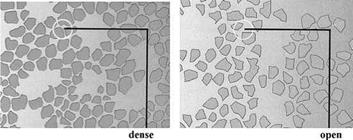The primary attraction for producing wheels with high structure numbers is to allow the highest levels of porosity to be produced while still maintaining structural integrity. This provides for very good coolant access and chip clearance in the grinding process. However, it is very difficult to maintain green strength and the integrity of the pores during manufacture of the wheel without additives to act as structural supports or “pore formers.” These are typically either hollow particles such as bubble alumina, glass beads, or mullite, which remain an integral part of the wheel structure but break open at the grinding surface, or fugitive materials such as napthalene, sawdust, or crushed walnut shells that burn out in the firing process. Hollow particles maintain a strong and coherent wheel structure, while fugitive fillers leave a structure with a high permeability that allows coolant to be carried deep into the wheel. Fugitive pore formers also allow a great flexibility in the shape and size of the pore as shown in Figure 6.8 below. In particular, pore formers allow pore sizes much greater than the grit size to be readily induced.
Porosity
Grain
Bond
|
FIGURE 6.9 Comparison of regular induced porosity wheels and Poros 2 dual structure wheels. |

